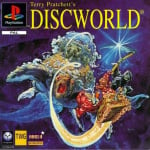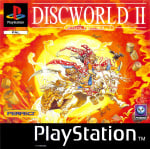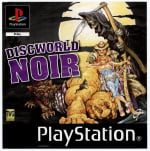
Don't worry – you're not suffering from déjà vu. If you feel like you've read this before, it's because we're republishing some of our favourite features from the past year as part of our Best of 2024 celebrations. If this is new to you, then enjoy reading it for the first time! This piece was originally published on February 6th, 2024.
In the mid-to-late '90s, the UK developer Perfect Entertainment partnered with the author Terry Pratchett to produce three games based on the writer's Discworld series of novels.
The series, which began all the way back in 1983, with the publication of The Colour of Magic, has won countless awards, shifted over a hundred million copies, and gone on to comprise an impressive 41 books in total (not counting its various spin-offs, graphic novels, and companions). Its final novel The Shepherd's Crown was published in August 2015 — five months after the author's unfortunate passing at the age of 66 from complications related to Alzheimer's.
As the name suggests, all of the books (and the games by extension) take place in an unconventional location called The Discworld — which is commonly described as a disc-shaped planet balanced on the backs of four elephants standing atop a giant turtle floating through space. Its various stories typically focus on the adventures (or misadventures) of The Disc's inhabitants, with some of the most memorable characters featured in its page including the wizard Rincewind, the witches Granny Weatherwax and Nanny Ogg, and the Ankh Morpork City Watch (to name just a few).
Even to this day, we constantly find ourselves returning to these books regularly and have always been fascinated with the video game adaptations of the series. So recently we decided to track down Gregg Barnett, the designer of the Discworld video games, to find out more about how they came to be, what it was like collaborating with Terry Pratchett, and if there's any possibility of any potential reissues or remasters of in the future. You can read a transcript of our conversation below (edited for length and clarity):
Time Extension: To start, it would be great to hear, what was your familiarity with the Discworld books like before you ended up pursuing the license? How did you first become aware of the books?
Barnett: People had spoken about them. So when I read the first couple, to me, I saw the foundation of a world and instances that would make good conversations in a game or good little events or puzzles. So before I even designed the game, I had read all the books that had been published up to that point – there might have been 9 or 10. I think we were up to Moving Pictures at that point or the second Witches book Sourcery. At that point, it was the biggest thing in the science-fiction fantasy world. This was pre-Harry Potter.
Time Extension: What were those initial negotiations like with Terry Pratchett? In the past, I believe there had been a Colour of Magic text adventure and that hadn’t done that well. And then, there was Simon the Sorcerer, where I believe Adventure Soft had tried to get the license and couldn’t. So I’m wondering, where was Terry’s head at concerning video game adaptations of his work?
Barnett: It’s a long story, I suppose. So I was in Melbourne and wanted to start Perfect Entertainment and I decided that Discworld would be the perfect vehicle for an adventure game. So I designed the game or the first version of the game. The first version was a bit different from the one that we ended up making, in that it had some RPG elements in there to a small extent and some other things — I can’t remember what they all were. But anyway, it was quite a complex design and once I’d done that, I sent it over to Angela (my business partner) in England and she approached Colin Smythe who was Terry Pratchett’s agent in London.
Terry said, ‘Let’s talk to them’ based on the fact there was a design and it wasn’t somebody coming in cold. I think by that point, I’d also gotten to the second design, which was exactly puzzle for puzzle what the end game ended up with. So Terry said to me to meet him in a theatre in Stratford-Upon-Avon, which was the theatre, I believe, where Stephen Briggs put the Discworld plays on. He took us to meet what he called some of the Discworld family. And basically, he read the design, liked it, and said, ‘Yeah.’
He didn’t even really haggle money or anything. He wasn’t too concerned about that. I was under the assumption at that time that we were the first people who had ever spoken to him because it was extremely easy — apart from the fact I had to do three weeks doing a detailed design. He was extremely friendly and the only debate and argument we had wasn’t with him, it was with the agent. The agent kept suggesting, ‘Why can’t you just do The Colour of Magic?’ And I said, ‘No, I want the Discworld. The whole Discworld.'
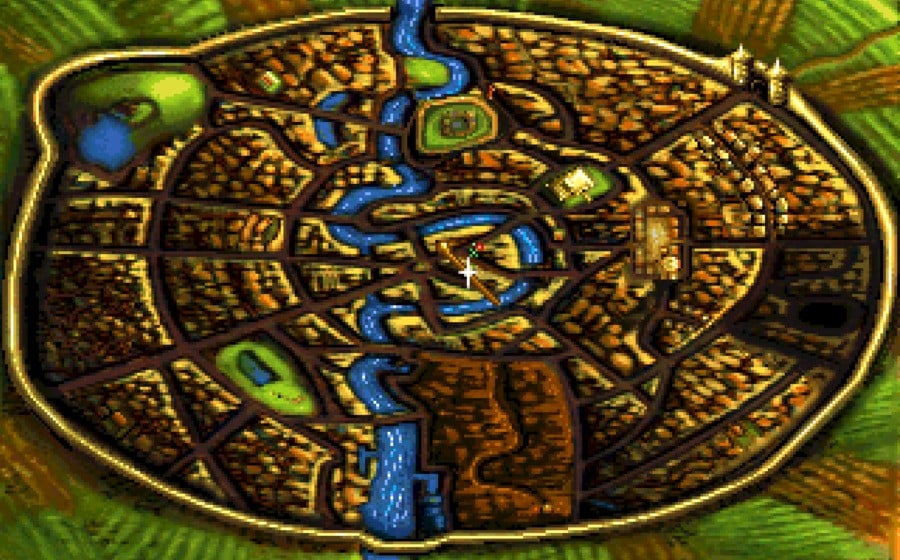
Afterward, so many people asked us, like publishers from EA to Psygnosis, ‘How did you get the deal? We went out to the agent with the big cheque in hand and we’ve just been told to piss off basically.’ I said, ‘I didn’t even have a cheque in hand. We didn’t even really talk about money. I just handed over a design.’
Time Extension: You mention that several publishers were amazed that you’d managed to obtain the license. How easy then was it to find a publisher for the game?
Barnett: I mean, in the case of Discworld 1, we actually started by speaking to Sierra On-Line in America. And we signed the contract with Sierra. I went over to the headquarters in California and spoke to Ken and Roberta Williams and we started working on the game on their engine.
At the time I was over there, they had this big New England barn with hundreds of employees and then all of a sudden it sort of tanked and they were leaking money everywhere so they cancelled all external projects. So the game got cancelled by them and it came back to us obviously. So we had some art and some scripting and everything but because we had been using their engine, we didn’t even have an engine at that point. So we decided we’d create our own engine and that’s when we started our Manchester team to build it.
We actually advertised in the English Computer Games Trade Magazine CTW that we wanted a publisher for the Discworld game. And we got three calls, I think, on the first day: Electronic Arts, Psygnosis, and I can’t remember who the third was.
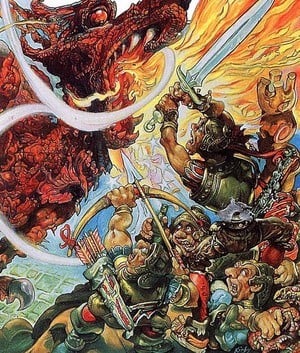
Electronic Arts came in first and they said they were interested but they would get back to us. Then Psygnosis came down from Liverpool that same week and their approach was the total opposite to EA. Whereas EA said, ‘Yes, we like it, but we’re going to go away and think about it', Psygnosis said, ‘We’re not leaving the office until you tell us yes or no.’ So they were basically sitting in our office and we were trying to figure out, ‘Do we go with these guys?' I don’t think by then they had let it be known that they’d tried to get Discworld themselves, but it came out soon after that they had tried very hard to get it. So we agreed to sign up with them and they handed over the advance.
Time Extension: The first game obviously draws somewhat on the plot of Guards! Guards! with the appearance of the dragon. What about that premise specifically appealed to you? Was that just one of your favourites from the books you'd read or did you just think that was an interesting concept to hang the game on?
Barnett: It was an interesting concept. I had actually said when I spoke with Terry that it was the first book that popped out when I was reading where it was like, ‘Wow, this is a full screenplay sort of plot here. This has got backstories and loops around. It isn’t just a sequential thing with good gags.’ So there was a deep story and I could see how it could be layered into a game.
Obviously, what you are looking for in a point-and-click adventure puzzle game, or at least what I was looking for, was something that could be broken up into 3-4 acts and then you could expand it out and have multiple quests related to an overarching thing. That sort of structure of the secret society and the dragon behind it all — all of that was ideal for me. Then it was easy to do gags and hang them off of that — whether they were slapstick ones or stupid ones or Terry Pratchett ones or Monty Python ones or whatever.
Besides Terry's work, we also had the advantage of the supporting books from Stephen Briggs, such as The Discworld Companion. So we had a guide to the world as well. It’s very easy to look at Discworld and say it was an ad-hoc mish-mash of lots of things (which it was), but at least in Terry's point of view there was consistency underneath it all and we had to understand that so we didn’t break any rules as he or his fan saw them. So the companion was ideal for that sort of thing.
Time Extension: The CD-ROM version of the first games includes Eric Idle in the role of Rincewind. Did Terry have any suggestions in terms of the voice casting?
Barnett: He did after the event – after I had already cast it. I don’t think I actually asked him who should voice Rincewind. The initial person we spoke to was John Cleese and he actually told us to ‘Fuck off’. That’s what he said: ‘Fuck off, I don’t do games.’ So we spoke to Eric Idle and the rest is history. During the recording session, I mentioned to Eric what John said, and he said, ‘Yep, that sounds like John.’ But after that, Terry did say that his idea of Rincewind was always based on Rodders out of Only Fools & Horses.
Beyond that, his only comment was obviously the librarian is an orangutan and not a monkey, but that was more of a joke that he made as a comment in an email. You’ve got to bear in mind that his main interest was in making the game loyal to the fans and what they believed Discworld was. He started things off, but quite often because of misunderstandings and fan beliefs, things changed and they weren’t how they started.
Time Extension: Do you have any insight into how you approached the world and its characters in while designing the first game?
Barnett: Terry's way of looking at the world was ‘Ordinary people in an extraordinary world’. His characters weren’t extraordinary. Even ones like the Cohen character who tried to be a hero was an old guy hobbling around. There weren’t any exceptional heroes — Rincewind was as flawed as you could get a hero to be — but the world and the opportunities for misunderstandings and stuff were huge in the way he portrayed it.
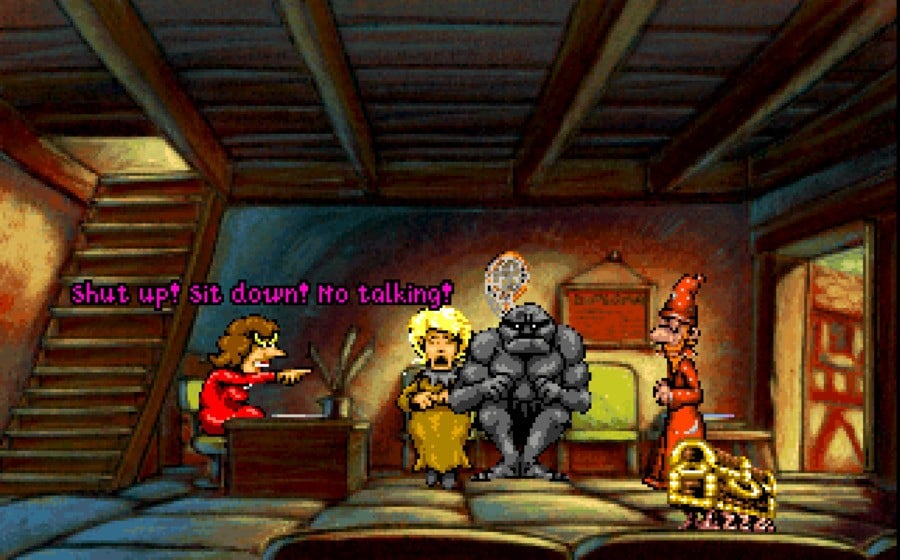
The key characters were obviously the Terry Pratchett characters of Rincewind, the wizards, Death, and the witches – all those characters that were staples in the book – and a lot of effort was put in to make sure they were as close as in those days we could get them to how not just Terry but the fans understood them to be. And then we sprinkled in original characters that could have been in the books, to hang more extravagant stuff off if need be. And Terry would actually add to those, like in Discworld 1, I had the psychologist or something and Terry turned him into a retrophrenologist (where they hit people with a hammer to change their personality). So he would play along with the new characters.
Time Extension: One of the big things about the original game that kind of got criticized at the time of release was the puzzles. What are your thoughts on this?
Barnett: Obviously, some people have said Discworld 1 in particular is super hard, but the interesting thing is the way I designed it was if you just went step by step through any particular puzzle strand or any particular quest and just followed it step by step, it would lead you a little bit by the nose.
But because there was, at any given time, three or four or more strands open and the inventory did get quite large at times, experienced players who were taking shortcuts got tangled up more often than not.
And it was interesting because we even got mail from people in their 80s saying how easy they found it and that it was such a good experience. They just played it through the way the story led them by the nose. But then you had experts who had done King’s Quest and Simon the Sorcerer and so on saying, ‘Oh we can’t do this. These puzzles are so crazy.’ It was just interesting. So in Discworld 2, I made it so there were multiple ways of getting to the same answer.
Time Extension: In Discworld II, you also got an original song from Eric Idle. I’m wondering, how did that come about?
Barnett: Discworld II had a bigger budget. There was already some success and there was a clamouring for a sequel – and I already had an idea for what the sequel was going to be anyway; that was more to do with books based on the death line and the Moving Pictures ones. So films and death.
So because I had a scene with Eric on the cross as Bone Idle — which I remember getting to that part and Eric saying, ‘You’re causing me childhood trauma. They used to call me bone idle at school’ — I actually asked him whether he could just do another version of Bright Side of Life, but make it Look on the Bright Side of Death because I was obviously trying to play around with those words.
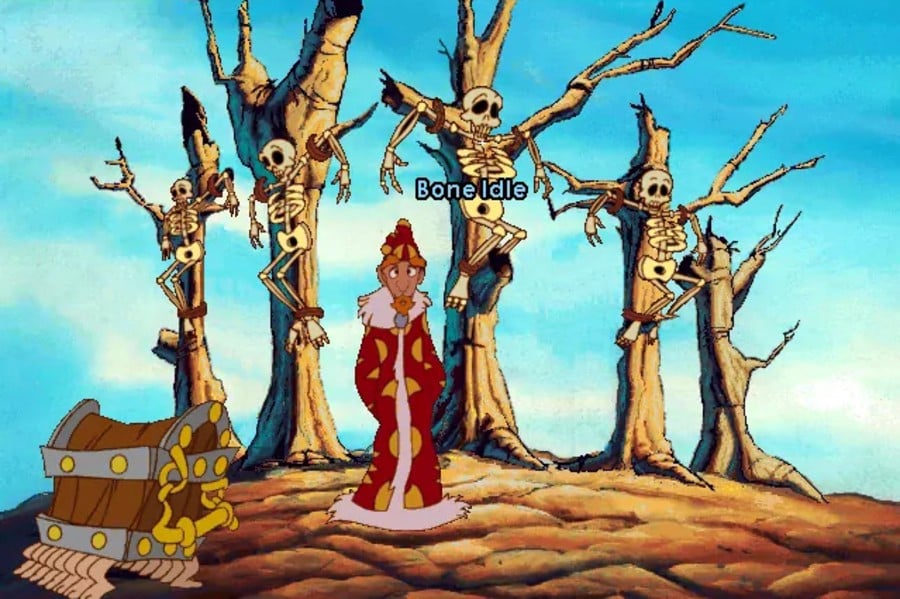
He said, ‘Yeah, maybe’ and he went away and he came back to me and said, ‘Look, I don't want to collaborate. I'll do something for free. I’m in Las Vegas and I’ve got some mates who are the best jazz musicians in the world. We’ve all agreed we’re going to spend a few days and just have a great time and do something and I’ll give it to you at the end. If you’re happy, you can use it. We’re not going to charge you anything for it.’ And he came back and it was good, and so we then took it and we animated it where we had the band and death and everything, and the skeleton singers and skeleton chorus girls and whatever.
Time Extension: When it came to Discworld Noir and this idea of doing a noir take on the Discworld universe, what was the inspiration for that? In the past, I interviewed Chris Bateman, who was your co-designer on that project. He told me that it initially started with you and Terry having a chat somewhere over dinner. Is that your memory of events?
Barnett: Sort of, but not quite. Basically, I said to Terry, ‘We need to do a third game.’ Now I wanted to do a third game and I knew what I wanted to do, but I was a bit wary about the next part. Then Terry said, ‘Haven’t people seen everything? It would have to be something totally original.’ And that’s when I suggested doing a detective one or doing a noir version of the Discworld because there hadn’t been any detective novels.
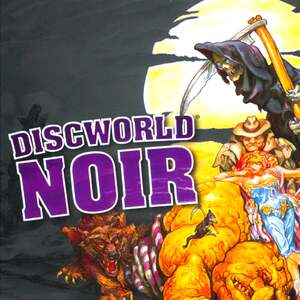
He had the City Watch but he hadn’t had any detectives yet, so I wanted to make it even more defined as a detective novel like The Maltese Falcon or Raymond Chandler books. So basically, then he said, ‘Yeah, that sounds great! No problem, I trust you. Just work out a story and show it to me.’
So Chris [Bateman] had come on at the end of Discworld II, so I went through that the high-level story stuff and the films and a couple of things with him. Chris wasn’t a comedy puzzle guy. He was more of a normal puzzle story guy, so he did puzzle things based on more subtle parody and satire. I provided some hangers and some things for him to hang stuff on and he went away and fleshed it all out and did the dialogue for that as well.
In the first two games, we made sure the scriptwriter could emulate Terry’s style as much as he could, but it didn’t matter in Discworld Noir because it was an original take. So the voice was original. It wasn’t so much Terry’s voice we were trying to emulate for the conversations and stuff as a new sort of noir take on the Discworld. Then we mixed in the horror stuff. That was already there from the start because we wanted to try a new technique with the sniffing and smelling and whatever – try something to add to the detective stuff — which was the werewolf stuff.
Time Extension: Was there any aspect of Discworld that you would have liked to have gone deeper on? Maybe like the Pyramids side and Small Gods? Or maybe some of the assassins’ stuff? Were there any other aspects of Discworld that you were hoping you would eventually get round to in a game?
Barnett: I spoke to Rhianna Pratchett a few years back now. Unfortunately, before Terry passed away, him or his agent or somebody had signed off every property to either ITV or Prime or BBC literally across the board. Even Rhianna was having a bit of trouble because she was trying to script some of the Susan books, I think.
I did ask her because I said, ‘I would like to do a definitive game on the Guards but she said, ‘Unfortunately, they are making a TV show of it’. At the time, I had some really innovative ideas on how to use all of the guards as different detectives with their own particular abilities – you had the werewolf, you had the vampire, you had the dwarf, and so on and so on. That was where I wanted to go all the way just do a procedural detective thing. Not a noir thing but a proper procedural detective thing with the withes and the guards and whatever.
So that would have been the one thing that I would have liked to have done. It’s not the most fantastic thing if you’ve seen the other books, but it was just something where Terry had done so much foundational work so it just would have been great to have done something. And if you approached the people who made the TV series, they’re going to want it in the image of the TV series, which is the image I won’t do it in anyway.
Time Extension: There are a lot of companies now that do re-releases of old games. A lot of their work is detective work to find out who was involved in certain deals to try and track down rights. I know Rhianna herself has said nobody really knows who owns the rights to the original games. I’m wondering, has anyone approached you to try and track down that paperwork and see about rereleasing these games on modern hardware?
Barnett: Yeah! We are a little bit beyond that point. I don’t want to give you a scoop, but a Discworld rerelease may happen. The original rights are complicated in the UK, but it turns out that 50% reverted to me as the creator because the company Perfect Entertainment had been closed for over 10 years.
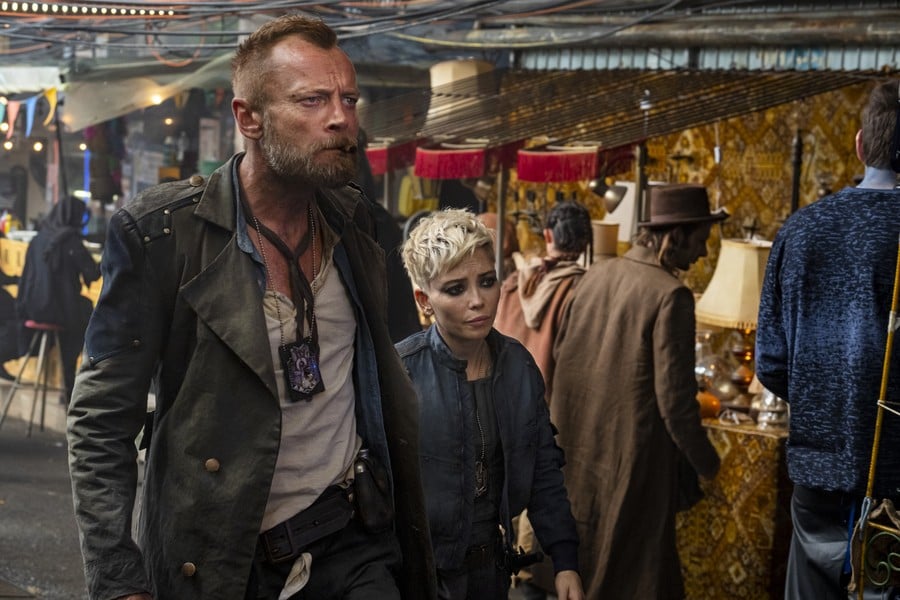
Whenever something closes in the UK, intellectual property rights revert 50% to the original creator and 50% to the crown, which is King Charles. So that’s the two owners of the games. So yes, there have been discussions and something may be happening down the track – a rerelease or a remaster. But it’s obviously a complicated process when you’re dealing with the crown.
Time Extension: Yeah, it would be interesting to see them be re-released. At the moment, it requires a bit of googling to get those up and going again, so it would be interesting to see them thrown open to anyone that just loves Discworld and doesn’t want to do a ton of research on forums to find out how to get their old copies up and running.
Barnett: Yeah, hopefully that will happen. It’s on the cards. It may happen. And then it could advance to new versions of them. And again, I said, I would like to do a new Discworld game. But beyond all of the stuff that may or may not happen [like] the old versions, it’s just going to be hard to get the rights to do anything new in the Discworld universe at the moment.

